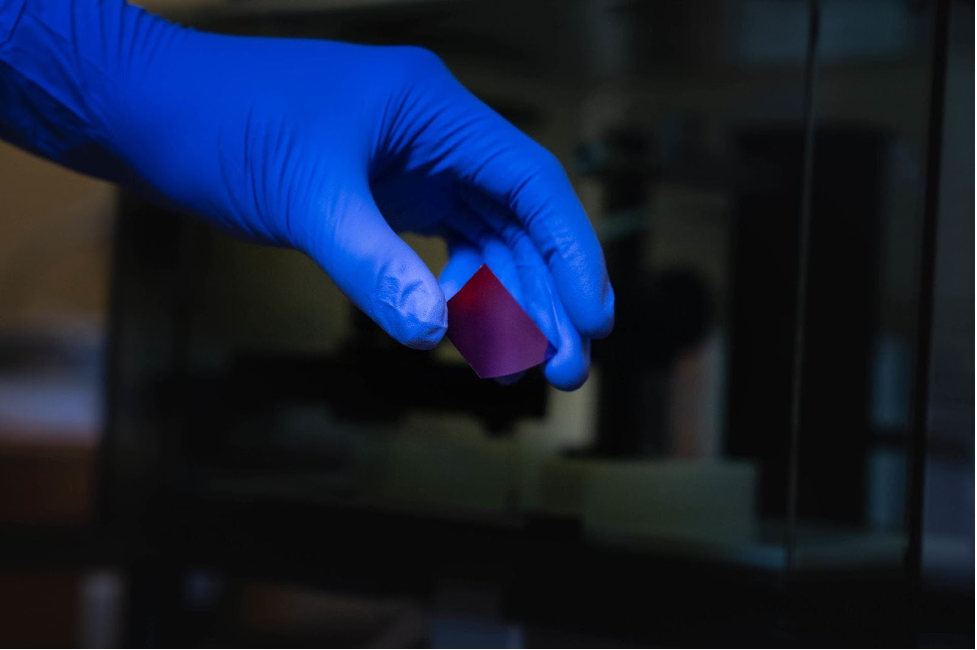The strength of 2D materials has proven challenging to harness, despite being among the world’s strongest materials.
 A sample of the covalent organic framework material that researchers found preserves its 2D mechanical properties as a multilayer stack. Image Credit: Gustavo Raskosky/Rice University
A sample of the covalent organic framework material that researchers found preserves its 2D mechanical properties as a multilayer stack. Image Credit: Gustavo Raskosky/Rice University
Due to their extraordinary mechanical characteristics, 2D materials that are thinner than the finest onion skin paper have drawn much attention. However, when the materials are stacked in numerous layers, those characteristics disappear, which limits their applicability.
Think of a graphite pencil. Its core is made of graphite, and graphite is composed of many layers of graphene, which has been found to be the world’s toughest material. Yet a graphite pencil isn’t strong at all—in fact, graphite is even used as a lubricant.
Teng Li, Keystone Professor, Department of Mechanical Engineering, University of Maryland
By meticulously adjusting the molecular structure of 2D polymers known as covalent organic frameworks (COFs), Li and colleagues at Rice University and the University of Houston have discovered a method to overcome this obstacle. A recent study that was released in Proceedings of the National Academy of Sciences details the results.
It is a very exciting starting point.
Jun Luo, Professor, Material Science and NanoEngineering, University of Maryland
The researchers created two COFs with slight structural variations after studying various functional groups—that is, arrangements of molecular elements—using molecular-level simulations. The behavior of the COFs in layers was then investigated. It emerged that the minor structural variations produced noticeably different results.
Like most 2D materials, the initial COF displayed only a feeble interplay between layers, and as more layers were added, both strength and flexibility diminished.
Second COF exhibits strong interlayer interaction and retains its good mechanical properties even as multiple layers are added.
Qiyi Fang, Study Co-Lead Author and Doctoral Student, Rice University
Researchers concluded that hydrogen bonding is most likely responsible for this phenomenon.
Study co-lead author Zhengqian Pang, a UMD post-doctoral researcher and a member of Li’s research group, added, “We found from our simulations that the strong interlayer interactions in the second type of COF result from the significantly enhanced hydrogen bonding among its special functional groups.”
The study team then used their results to create a lightweight material that not only has a strength greater than that of steel but also retains its 2D properties even when stacked into multiple layers.
There are many potential applications.
Lou added, “COFs could make excellent filtration membranes, for instance. For a filtration system, the functional group structure at the pore will be very important. As you have, say, dirty water traveling through a COF membrane, the functional group at the pore will capture the impurities only and allow the desired molecule to pass.”
“In this process, the mechanical integrity of that membrane will be very important. Now we have a way to design very strong, very fracture-resistant, multilayer 2D polymers that could be very good candidates for membrane filtration applications,” he stated.
He further pointed out, “Another potential application is for upgrading batteries: Replacing the graphite anode with a silicon one would greatly increase the storage capacity of current lithium-ion battery technologies.”
Li said that the study’s insights could further enhance the construction of a variety of materials, such as metals and ceramics. For instance, ionic bonding, which develops in ceramics at very high temperatures, makes it difficult to repair a shattered coffee mug.
Similarly, shaping metals at high temperatures is necessary. Similar products could theoretically be produced and repaired without increasing heat, thanks to molecular tweaking being investigated by researchers.
Li concluded, “Although the immediate context is 2D materials, more generally we’re pioneering ways to exploit the advantageous properties of materials without the constraints these materials present.”
The study was funded by the Welch Foundation (C-1716), the Maryland Advanced Research Computing Center, and the Army Research Laboratory Cooperative Agreement (W911NF-18-2-0062).